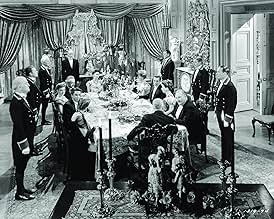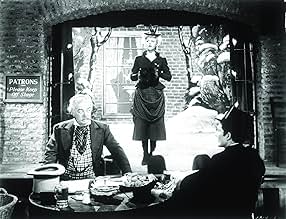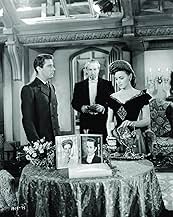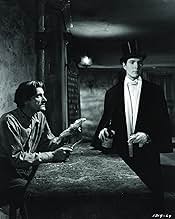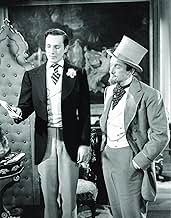AVALIAÇÃO DA IMDb
7,5/10
15 mil
SUA AVALIAÇÃO
Um jovem corrupto de alguma forma retém sua beleza juvenil, mas uma pintura especial revela gradualmente sua fealdade interior a todos.Um jovem corrupto de alguma forma retém sua beleza juvenil, mas uma pintura especial revela gradualmente sua fealdade interior a todos.Um jovem corrupto de alguma forma retém sua beleza juvenil, mas uma pintura especial revela gradualmente sua fealdade interior a todos.
- Ganhou 1 Oscar
- 3 vitórias e 4 indicações no total
Renee Carson
- Young French Woman
- (as Renie Carson)
Lilian Bond
- Kate
- (as Lillian Bond)
Devi Dja
- Lead Dancer
- (as Devi Dja and Her Balinese Dancers)
- Direção
- Roteiristas
- Elenco e equipe completos
- Produção, bilheteria e muito mais no IMDbPro
Avaliações em destaque
Based on a story by Oscar Wilde, The Picture of Dorian Gray tells the story of a man that sells his soul for eternal youth. After having his portrait done, Dorian Gray, under the influence of the eloquent Lord Henry Wotton, wishes for the picture to age instead of him so that he may be blessed with eternal youth. After the death of his wife-to-be, Dorian embarks on a life of pleasure and sins, which don't affect the man in the slightest, but leaves it mark on the portrait which descends into a horrid impression of the handsome young man it's portraying...
This film is fantastically well put together. The acting, directing and writing are all stellar, which make this film one pleasant viewing indeed. The real plaudits for this movie, however, go to the writer of the original novel; Oscar Wilde. The story itself is ingenious. Of course, the idea of selling one's soul had been done before (the German legend, Faust, springs to mind instantly), but never in this way. The portrait itself is a genius idea and it allows us to see the man and the sin as different things. However, through it's ending; it also allows the audience to see that the two are linked, and overall giving a good commentary on body, soul and sin. The story has obvious themes of vanity and the lust for eternal youth entwined within it, both of which are sins in themselves. The main character of Dorian Gray is a man that is a victim of influence, and we can feel for him in that way; but he's also an ugly sinner on the inside, making the audience hate him. This is a strange situation for an audience to be in, and in the end; all that's left for him is indifference.
The film moves slowly, but this is definitely to it's advantage as it allows us to get to know the characters, and if it wasn't for that the horror wouldn't be able to work as it needs our emotional impact to function. The horror in the story is rather subdued, but this is one of the most horrific tales ever told. I think most people will agree that this kind of horror - the brooding, personal kind - is much more horrifying than anything that men with knives and any amount of jumpy moments can muster.
This film is fantastically well put together. The acting, directing and writing are all stellar, which make this film one pleasant viewing indeed. The real plaudits for this movie, however, go to the writer of the original novel; Oscar Wilde. The story itself is ingenious. Of course, the idea of selling one's soul had been done before (the German legend, Faust, springs to mind instantly), but never in this way. The portrait itself is a genius idea and it allows us to see the man and the sin as different things. However, through it's ending; it also allows the audience to see that the two are linked, and overall giving a good commentary on body, soul and sin. The story has obvious themes of vanity and the lust for eternal youth entwined within it, both of which are sins in themselves. The main character of Dorian Gray is a man that is a victim of influence, and we can feel for him in that way; but he's also an ugly sinner on the inside, making the audience hate him. This is a strange situation for an audience to be in, and in the end; all that's left for him is indifference.
The film moves slowly, but this is definitely to it's advantage as it allows us to get to know the characters, and if it wasn't for that the horror wouldn't be able to work as it needs our emotional impact to function. The horror in the story is rather subdued, but this is one of the most horrific tales ever told. I think most people will agree that this kind of horror - the brooding, personal kind - is much more horrifying than anything that men with knives and any amount of jumpy moments can muster.
It's hard to say what it is about "The Picture of Dorian Gray" that I enjoyed so much, but I did like it. Hurd Hatfield at first seems miscast and ineffective as the titular character, but somewhere around the one hour mark, his one and only expression begins to grow on you until you feel just as unnerved by his presence as those who come in contact with him in the story. George Sanders--from what I've seen--played one character his enter career but played it so well, and his performance in this film is no exception. Angela Lansbury is surprisingly sympathetic as the sad and timid singer. The only one in the cast who really doesn't work is Donna Reed. Her character feels tacked on, and she isn't allowed to do much but look faithful and beautiful.
The film is shot wonderfully, and Harry Stradling's cinematography gives the East End scenes a dark, atmospheric counter balance to the rather plain and flat interiors of Dorian's home. The swinging lamp was a nice touch and reminded me of "Psycho"'s finale.
I suppose my only criticism is toward the end, the story introduced one or two characters without giving them proper context or background (I'm thinking of the Allen Campbell character). I'm assuming Dorian "convinces" him to take part in his plans because of some sort past homosexual tryst, but it seemed unfair to bring him in they way he was, have him serve the role he does, and then disappear so quickly without explanation. And speaking of suggested themes: Is it just me, or could you make an argument that Dorian is Jack the Ripper? Maybe it's actually pretty obvious or maybe I'm just interpreting too much into the story, but that's what I got out of it.
P.S. I had the opportunity to see the actual painting from the film during an Ivan Albright exhibit at the Metropolitan Museum of Art in 1997. It's even more gruesome in person.
The film is shot wonderfully, and Harry Stradling's cinematography gives the East End scenes a dark, atmospheric counter balance to the rather plain and flat interiors of Dorian's home. The swinging lamp was a nice touch and reminded me of "Psycho"'s finale.
I suppose my only criticism is toward the end, the story introduced one or two characters without giving them proper context or background (I'm thinking of the Allen Campbell character). I'm assuming Dorian "convinces" him to take part in his plans because of some sort past homosexual tryst, but it seemed unfair to bring him in they way he was, have him serve the role he does, and then disappear so quickly without explanation. And speaking of suggested themes: Is it just me, or could you make an argument that Dorian is Jack the Ripper? Maybe it's actually pretty obvious or maybe I'm just interpreting too much into the story, but that's what I got out of it.
P.S. I had the opportunity to see the actual painting from the film during an Ivan Albright exhibit at the Metropolitan Museum of Art in 1997. It's even more gruesome in person.
It is a mystery. Or is it mind over matter? The power of a mysterious painting depicted in this timeless tale of Oscar Wilde's imagination -- probing the depth of life's meaning.
It's costume drama, story began in London 1886. Definitely has an element of intrigue -- "a painting with a life of its own". It's eerie. It's dramatic. Its theme is scary. Such is a "deadly" wish of the main character, Dorian Gray: "If only the picture (a portrait of Dorian Gray) can change, and I can always be as I am now. I'd give my soul for that." Dorian Gray's obsession with youth became eternal youth.
Imagine that as time goes by, he will always stay the same rich attractive young man that he is -- never grow old, while the picture will take on the changes -- his soul and character. Conscience, no longer he has -- the picture took it on. The story describes how Dorian Gray spends his life henceforth and the consequences that entail.
A very young Angela Lansbury, after her debut in George Cuckor's 1944 "Gaslight", portrays the innocent young actress Sibyl Vane from the poor side of town. The bet between the characters of George Sanders and Hurd Hatfield brought to mind the cruel intentions of Neil LaBute's 1997 "In the Company of Men". George Sanders is the cynical callous Lord Henry Wotton. The events all happen in a seemingly civil manner, immersed in the society of the rich. Have and have-nots are juxtaposed.
The film is essentially in Black and White, with only the specific content of the picture of Dorian Gray in color when we see it through Dorian's eyes.
It's another B/W classics gem, well-cut and impeccably presented. It encompasses sentiments and all elements: mystery, intrigue, love lost, friendships, regrets, and fear. Dorian Gray with a tormented inside -- pining for the return of his soul. Is this the Devil's advocate? You see no hell depicted as in Vincent Ward's 1998 "What Dreams May Come", or Woody Allen's 1997 "Deconstructing Harry" or Taylor Hackford's 1998 "The Devil's Advocate". No glamorous, elaborate take on the Devil, but the atmosphere provided that suggestion. There's no special effects, yet you can feel the twistedness: a man asking for help within yet unable to help himself because he's a lost soul. The temperature of the movie seems like being in 10 degree Celsius -- cold in sentiment and tone. There was a glimmer of warmth -- it flickered and faded with the innocent Sibyl Vane character.
The subject matter is timeless even though the film was made in 1945. The story is fascinating in spite of the pace which may not be at breakneck speed as in today's action packed, sound effects filled movies.
You can say it's pseudo sci-fi -- a foreboding tale it is. By and by, Dorian Gray's unchanging mask-like face reminds me of "Mr. Sardonicus" (William Castle's 1961). His behaviors are no longer placid -- gradually turning into hideous evils. This film questions one's probity. The mystery of life is to live it not to attain immortality. How uninteresting it'd be to be changeless and ageless? (John Boorman's 1974 sci-fi "Zardoz" with Sean Connery and Charlotte Rampling came to mind). Growth and change are intrinsic elements of life. Life and death go hand in hand cyclically. A truly worthwhile effort from writer/director Albert Lewin.
It's costume drama, story began in London 1886. Definitely has an element of intrigue -- "a painting with a life of its own". It's eerie. It's dramatic. Its theme is scary. Such is a "deadly" wish of the main character, Dorian Gray: "If only the picture (a portrait of Dorian Gray) can change, and I can always be as I am now. I'd give my soul for that." Dorian Gray's obsession with youth became eternal youth.
Imagine that as time goes by, he will always stay the same rich attractive young man that he is -- never grow old, while the picture will take on the changes -- his soul and character. Conscience, no longer he has -- the picture took it on. The story describes how Dorian Gray spends his life henceforth and the consequences that entail.
A very young Angela Lansbury, after her debut in George Cuckor's 1944 "Gaslight", portrays the innocent young actress Sibyl Vane from the poor side of town. The bet between the characters of George Sanders and Hurd Hatfield brought to mind the cruel intentions of Neil LaBute's 1997 "In the Company of Men". George Sanders is the cynical callous Lord Henry Wotton. The events all happen in a seemingly civil manner, immersed in the society of the rich. Have and have-nots are juxtaposed.
The film is essentially in Black and White, with only the specific content of the picture of Dorian Gray in color when we see it through Dorian's eyes.
It's another B/W classics gem, well-cut and impeccably presented. It encompasses sentiments and all elements: mystery, intrigue, love lost, friendships, regrets, and fear. Dorian Gray with a tormented inside -- pining for the return of his soul. Is this the Devil's advocate? You see no hell depicted as in Vincent Ward's 1998 "What Dreams May Come", or Woody Allen's 1997 "Deconstructing Harry" or Taylor Hackford's 1998 "The Devil's Advocate". No glamorous, elaborate take on the Devil, but the atmosphere provided that suggestion. There's no special effects, yet you can feel the twistedness: a man asking for help within yet unable to help himself because he's a lost soul. The temperature of the movie seems like being in 10 degree Celsius -- cold in sentiment and tone. There was a glimmer of warmth -- it flickered and faded with the innocent Sibyl Vane character.
The subject matter is timeless even though the film was made in 1945. The story is fascinating in spite of the pace which may not be at breakneck speed as in today's action packed, sound effects filled movies.
You can say it's pseudo sci-fi -- a foreboding tale it is. By and by, Dorian Gray's unchanging mask-like face reminds me of "Mr. Sardonicus" (William Castle's 1961). His behaviors are no longer placid -- gradually turning into hideous evils. This film questions one's probity. The mystery of life is to live it not to attain immortality. How uninteresting it'd be to be changeless and ageless? (John Boorman's 1974 sci-fi "Zardoz" with Sean Connery and Charlotte Rampling came to mind). Growth and change are intrinsic elements of life. Life and death go hand in hand cyclically. A truly worthwhile effort from writer/director Albert Lewin.
This film adaptation of Wilde's story is certainly one of the great atmospheric black and white films of the 40's. Reminiscent of Greg Toland's ground breaking deep focus cinematography in "Citizen Kane",the shades of black, greys and whites are sharp and clearly deliniated to produce an unforgettable, somewhat eerie look to the film. There are a couple of short Technicolor shots that will make you jump. Cinematography is the star here but let's talk about Hurd Hatfield. I have seen this film on numerous occasions and have yet to figure out whether Hatfield is a great actor or just a woodenly inanimate object. Whichever is the case, this is the role of a lifetime.....it calls for an unfeeling, blank-faced characterization which is exactly as Hatfield played it. His smooth unlined visage hides many things and his apparent lack of emoting is right on target. Does that mean that he just couldn't act and fell into a role that suited his style or does it mean that he rose to the task and his interpretation was the sign of a great actor, living the part. I don't know....all I do know is that he pulls it off with great panache! He was playing against one of the great scene stealers of all times, George Sanders, who spouts Wilde epigrams with his own inimitable class and Hatfield holds his own. The other players are adequate but I don't know what all the excitement is about Angela Lansbury's acting....she was much better in "Gaslight". All in all, this is a movie that I would recommend but beware....it moves slowly, very slowly. Once you see it maybe you can answer the question about Hurd Hatfield's acting.....or maybe not!!!
Elegant, atmospheric and measured. I suppose anyone brought up on fin de siecle Hollywood would interpret that as `slow and boring'. But this was Hollywood tackling an intellectual piece with, well, intellect. I must confess that the thought of a 1945 Hollywood attempt at Oscar Wilde did not appeal. Memories of one or two previous efforts at English literary classics set alarm bells ringing. But this was in a class of its own. Beautifully photographed in black and white, apart from a couple shots of the painting itself, the aesthetics shimmer.
I wasn't that convinced about some of the London scenes, especially the low-life portrayal of the East End. The opium den and the `Two Turtles', where Gray first meets Sibyl Vane, look rather too genteel. Compare this view of such places with those created by David Lean, just a couple of years later, in `Oliver Twist'. And this, in a sense, detracts from the depths to which Gray descends in order to be forever youthful and live life with scant regard for others. And in many years of watching BBC Victorian costume dramas I don't recall seeing such outfits on the backs of London's society ladies! However some of the other detail is first class. In particular Sir Thomas's decision to remain at table (`never could resist Aunt Agatha's quails') in spite of Lord Henry's outrageous comments rings true through to today. As the script had it `think like a Liberal, eat like a Tory'.
The acting is excellent with Hurd Hatfield's portrayal quite remarkable in that he wears the same expression virtually throughout, in order, no doubt, to conceal his true emotions. George Sanders, as Lord Henry, steals every scene he's in thanks to a rapid delivery of Wilde's witticisms that would have Groucho Marx and Woody Allen in awe. Angela Lansbury is, perhaps, a little too demure for a theatrical singer from the East End but, no doubt, this was a result of director's orders.
Essential viewing for anyone interested in the history of film.
I wasn't that convinced about some of the London scenes, especially the low-life portrayal of the East End. The opium den and the `Two Turtles', where Gray first meets Sibyl Vane, look rather too genteel. Compare this view of such places with those created by David Lean, just a couple of years later, in `Oliver Twist'. And this, in a sense, detracts from the depths to which Gray descends in order to be forever youthful and live life with scant regard for others. And in many years of watching BBC Victorian costume dramas I don't recall seeing such outfits on the backs of London's society ladies! However some of the other detail is first class. In particular Sir Thomas's decision to remain at table (`never could resist Aunt Agatha's quails') in spite of Lord Henry's outrageous comments rings true through to today. As the script had it `think like a Liberal, eat like a Tory'.
The acting is excellent with Hurd Hatfield's portrayal quite remarkable in that he wears the same expression virtually throughout, in order, no doubt, to conceal his true emotions. George Sanders, as Lord Henry, steals every scene he's in thanks to a rapid delivery of Wilde's witticisms that would have Groucho Marx and Woody Allen in awe. Angela Lansbury is, perhaps, a little too demure for a theatrical singer from the East End but, no doubt, this was a result of director's orders.
Essential viewing for anyone interested in the history of film.
Você sabia?
- CuriosidadesIvan Le Lorraine Albright's famous painting of the decayed Dorian Gray, which took approximately one year to complete, is now owned by the Art Institute of Chicago, where it has been on display for many years. Albright's twin brother Malvin, better known as a sculptor, was also commissioned to create a painting of the young Dorian for this movie, although his work went unused. The March 27, 1944, issue of Life Magazine included a story and photos of the brothers working on their paintings for this movie. Henrique Medina created the initial portrait of young Dorian that sets the story in motion.
- Erros de gravaçãoAt approximately 34:35 into the film, the time on the clock in the room suddenly changes from just after 2 o'clock to 3 o'clock. Then at approximately 37:00 it moves back to 2:05 and then to 2:09 as Dorian continues to play the piano.
- Citações
Lord Henry Wotton: "If I could get back my youth, I'd do anything in the world except get up early, take exercise or be respectable."
- Versões alternativasSome prints are slightly edited, omitting Dorian's prayer and Lord Henry's line, "Heaven forgive me" in the final scene.
- ConexõesFeatured in The Cinematographer (1951)
- Trilhas sonorasGood-Bye, Little Yellow Bird
(uncredited)
Lyrics and Music by C.W. Murphy and William Hargreaves
Performed by Angela Lansbury
Principais escolhas
Faça login para avaliar e ver a lista de recomendações personalizadas
Detalhes
- Data de lançamento
- País de origem
- Central de atendimento oficial
- Idioma
- Também conhecido como
- El retrato de Dorian Gray
- Locações de filme
- Empresa de produção
- Consulte mais créditos da empresa na IMDbPro
Bilheteria
- Orçamento
- US$ 3.500.000 (estimativa)
- Tempo de duração1 hora 50 minutos
- Cor
- Proporção
- 1.37 : 1
Contribua para esta página
Sugerir uma alteração ou adicionar conteúdo ausente


